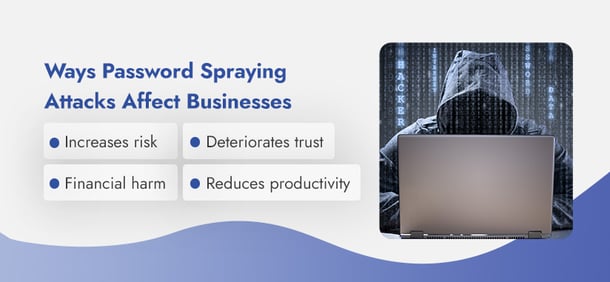What Is Password Spraying? How Can It Affect Customers?
Brute force attacks like password spraying have been on the uptick recently, according to Microsoft's team of experts. Although only about 1% of these attacks are successful, they can be devastating. Affected companies often suffer serious financial and reputational damage.
Knowing how to identify active password spraying attacks can help you mitigate risk. It can also help you prevent future attacks.
What Is Password Spraying?
Password spraying is a type of brute force attack that involves malicious actors attempting to log in to as many accounts as possible using the same password for each attempt. This is also sometimes referred to as the "low-and-slow" method.
Usually, an attacker will begin by gaining access to a list of usernames for your organization or for specific applications. They may also buy stolen credentials posted on the dark web. Then, they'll attempt to log in to each account from several different IP addresses using the same common or default passwords for each round of attempts.
Because the attackers are spreading a smaller quantity of attempts across a larger quantity of accounts, they are harder to detect, which improves the attacker's chances of gaining access. This helps to avoid the account lockouts that will often occur when attackers use a brute force attack on a single account by trying many passwords. Hackers also often automate this process to be more efficient.
Typically, attackers will target systems or applications where new users log in with a default password. New users, or those who forget to set new passwords, are at the most risk.
Other targets can include:
- Single sign-on (SSO) applications
- Cloud apps
- Email apps
- Externally facing apps
- C-suite executives
Once they have entered your system, an attacker usually aims to cause as much damage as possible. Even though they can only access a single account, attackers can leverage it to steal sensitive information or spread malware in companywide emails. Proactive vigilance is critical for mitigating these risks.
How Do Password Spraying Attacks Affect Businesses?
If an intruder manages to get deep enough into your organization's system, the damage can be catastrophic. Here are some of the ways password spraying attacks can harm businesses of any size:

- Increases risk: Password spray attacks open your company up to further attack. For example, an attacker could launch a phishing attack against your employees or your customers once they have your credentials.
- Financial harm: In 2022, the average cost of a data breach was $4.35 million. Hackers can break into your financial accounts and steal funds or make fraudulent purchases. The longer they're in your system, the more money your company stands to lose.
- Deteriorates trust: Password spray attacks make customers uneasy about sharing their information with your company. As a result, they're likely to take their business elsewhere.
- Reduces productivity: Once they enter your system, attackers can interfere with your day-to-day operations. For example, they could cancel purchases or steal critical information, slowing productivity.
Taking proactive steps to prevent and detect attacks is the most effective solution. Password protection technologies and employee training are key tools for bolstering your protections.
Preventing Password Spraying Attacks
Password spray attacks depend on people being careless with their passwords, either using the same ones for multiple accounts, or creating weak passwords. Implementing robust security policies and controls can help you protect against these and other brute-force attacks. Some examples of helpful protections include:
- Multi-factor authentication (MFA): MFA requires users to provide two or more verification factors to log in, reducing the risk of someone logging in using a stolen password. Implement MFA both for internal employee accounts as well as external customer accounts, if possible.
- Account lockout policies: Lock users out of accounts after a certain number of failed login attempts. This technique reduces the chances of a successful illegitimate login.
- CAPTCHA: Password spray attacks are often automated to reach as many accounts as possible in a short period. CAPTCHA ensures that only human beings can log in to protected accounts, even if the bot uses the right credentials.
- Zero trust: Implementing a zero trust policy limits users' access to only the resources they need to complete their tasks. This minimizes the potential damage a hacker could cause if they gain access to a standard user account.
- Login settings: You can configure single sign-on (SSO) platforms and identity access management (IAM) tools to detect abnormal activity. For example, you might look for spikes in failed logins, which can help you identify threats before they become serious problems.
- Login monitoring: Hiring an IT team to monitor login attempts allows you to catch criminals before they gain entry into your system while freeing your in-house IT team up to focus on their day-to-day tasks.
- Strong passwords: Require users to set strong passwords that are at least 10 characters long with special characters, uppercase letters, and symbols. Train employees on password requirements if necessary.
- Security awareness training: Ongoing security awareness training helps keep your staff up to date on cybersecurity threats like password spraying. Training also helps demonstrate why password security is so important so employees feel motivated to protect themselves.
Additionally, administrators and applications that use default passwords for new users should require users to change their passwords after their first login.
How to Spot a Password Spraying Cybersecurity Attack
There are three telltale signs of a password spraying attack:
- Login activity: Look for an abnormally high volume of login activity over a brief period of time, which is a sure sign that something is wrong.
- Login failures: A sudden rise in failed login attempts by active users is another clear sign of an attack.
- Inactive accounts: If the attacker has an outdated user directory, you might see login attempts from nonexistent or inactive users.
How to Handle a Password Spraying Attack
If you think you have an attack on your hands, you must act immediately to minimize damages. Here are the two main steps you need to take:
- Change admin passwords: When hackers break into your system, they often move laterally to gain access to the most privileged accounts. Immediately change all administrator passwords to prevent them from being compromised.
- Follow your incident response plan: Your organization should have an established protocol for handling cyberattacks. If you do not have one in place, or it has been a while since you have updated it, work with an incident response team to create one.
It can also be beneficial to seek out incident response and forensics services. After an attack, it can be difficult to determine how much of your system was breached and what data was stolen or compromised. Additionally, subsequent attacks like phishing emails may have exposed your system further. Consulting with a reliable expert can help you recover from an attack and strengthen your defenses for the future.
Hire Compass IT Compliance, LLC to Defend Your Business Against Cyber Attacks
Creating a strong incident response plan, mitigating risks, and training employees on an ongoing basis are critical steps for mitigating cybersecurity incidents. And with the recent rise in attacks, the best thing you can do for your company is to consult with cybersecurity professionals.
At Compass IT Compliance, we have more than a decade of experience in IT security, compliance, and risk management. Whatever your industry, you can count on our expert team to help you protect your organization against attack. Contact us today online or call us at (401) 353-3024 to learn more!
Contact Us
Share this
You May Also Like
These Related Stories

9 Easy Steps to Create Strong Passwords
.jpg)
What Does a Passwordless Future Look Like?
.jpg)
.webp?width=2169&height=526&name=Compass%20white%20blue%20transparent%202%20website%20(1).webp)
-1.webp?width=2169&height=620&name=Compass%20regular%20transparent%20website%20smaller%20(1)-1.webp)
No Comments Yet
Let us know what you think